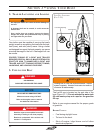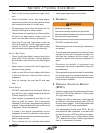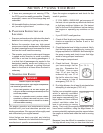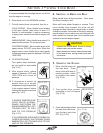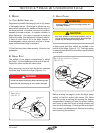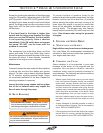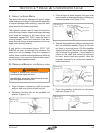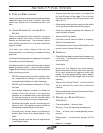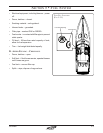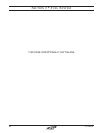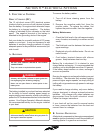
4.2
35 Outlaw
®
SeCtiOn 4 • Bilge & underwater gear
Except for checking the operation of the bilge pump
using the ON position, leave the switch in the OFF
(AUTO) position. In the OFF (AUTO) position, when
the bilge liquid is deep enough to activate the oat
switch, the bilge pump turns on and pumps out the
bilge liquid until the oat switch drops and shuts
off the pump.
If the liquid level in the bilge is higher than
normal and the bilge pump empties the bilge
when you use the ON switch, the oat switch
is not operating properly. Have it checked
immediately. If the ON switch does not operate
the pump, DO NOT use the boat until the
problem is corrected.
The emergency high water bilge pump and oat
switch are wired to the high water bilge alarm.
Should the pump be activated by water in the sump,
the alarm will sound. If alarm sounds, immediate
attention to the engine room is required.
Maintenance
Frequently inspect the area under the oat switches
to ensure they are free from debris and gummy
bilge oil. To clean, soak in heavy duty bilge cleaner
for 10 minutes, agitating several times. Check
for unrestricted operation of the oat. Repeat the
cleaning procedure if necessary.
Inspect the bilge pump intakes and keep them
free of dirt or material which may impede the
ow of water through the pump.
D. bilGe bloWer(s)
To prevent buildup of gasoline fumes to the
explosive level in the engine compartment, the bilge
blowers must be run for at least four (4) minutes
before starting the engine and kept running at all
times when the engine is running to insure that
there will be adequate ventilation when you are
moving slowly. The blowers may also remove
deadly carbon monoxide (CO) which may be in the
bilge. Run blowers when using the generator
or engine.
2. enGines anD sTern Drive
a. MainTenance anD service
Engine failure away from shore can be dangerous.
You must follow the recommended maintenance
schedule to best ensure trouble-free operation of
your engine and stern drive.
b. vibraTion anD causes
Some vibration is to be expected in your boat
because of the action of the engines and the
propeller. But excessive vibration indicates
conditions which must be promptly corrected to
avoid damage. The following are some conditions
which may cause vibrations.
• Weeds, ropes, shing lines, nets or your own trailing
lines can become wrapped around the propeller
and/or shaft, causing vibration and loss of speed.
Always stop the boat, make sure it is clear to the rear,
and then reverse the propeller after going through
a weedy area to unwrap and clear away any weeds
which may have accumulated. If this doesn’t clear
the entanglement, and you can’t anchor or moor
the boat in shallow water to get to the stern drive in
the water, the boat will have to be taken out of the
water.
• A badly damaged or distorted propeller or shaft is
an obvious cause of vibration. Run at slow speed to
shore. REPLACE IMMEDIATELY.
• If the engine mounts fail and the engine can contact
the hull while it is running, vibration will be felt. Run
at slow speed to shore. REPLACE IMMEDIATELY.
EXPLOSION/FIRE HAZARD – Run blower at least
four (4) minutes before starting engine or generator.
Check bilge and engine compartment for fumes.
! WARNING
Do not allow obstructions to interfere with bilge blower
or ventilation intake operation. Engine performance
may be adversely affected.
! WARNING




